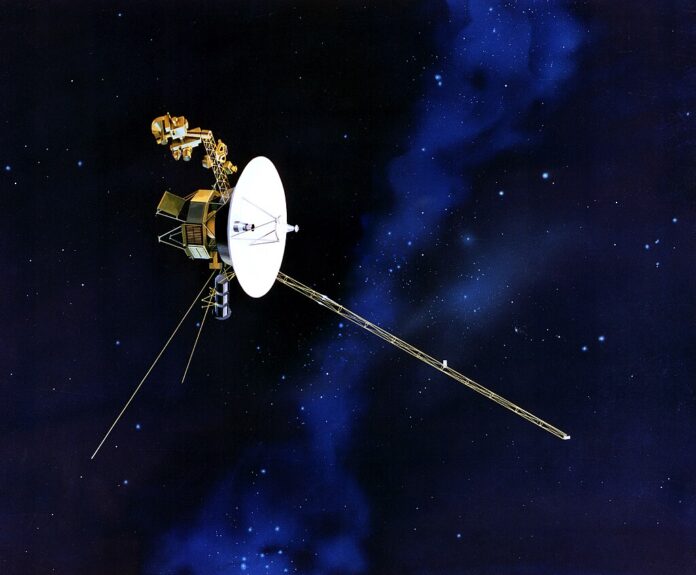Astronomers revisit decades-old data from NASA’s Voyager 2 flyby, revealing unexpected insights into Uranus’s magnetic field and its mysterious behaviour.
Forty years ago, NASA’s Voyager 2 spacecraft made history when it ventured to the outer reaches of our Solar System, giving scientists their first-ever close-up glimpse of the ice giant, Uranus. The spacecraft’s 1986 flyby marked a pivotal moment, as it remains the only mission to visit Uranus to date. However, new insights suggest that some of the unusual observations recorded during that historic encounter might have been purely coincidental.
When Voyager 2 passed by Uranus, planetary scientists were eager to uncover the secrets of this peculiar world. Unlike its neighbours, Uranus rotates on its side, presenting a tilted axis that makes it unlike any other planet. It is also the coldest planet in the Solar System, despite not being the farthest from the Sun. The spacecraft’s mission revealed a wealth of surprises, including previously unseen moons and a complex system of rings, expanding humanity’s understanding of this enigmatic planet.
Embed from Getty ImagesYet, what puzzled scientists the most were the energised particles Voyager 2 detected within Uranus’s magnetosphere. These findings contradicted their existing understanding of how planetary magnetic fields trap radiation. The strange data suggested that Uranus was a unique anomaly in the Solar System, raising more questions than answers.
A recent study by a team of astronomers, however, has revisited the original data from that flyby, aiming to solve the long-standing mystery. The new analysis indicates that what Voyager 2 detected might have been a rare phenomenon rather than an inherent feature of Uranus itself.
A Coincidence of Cosmic Timing
In the days leading up to the spacecraft’s approach, Uranus experienced an unusual bout of space weather. This event, the study reveals, compressed the planet’s magnetic field, significantly altering its magnetosphere. According to Jamie Jasinski, a leading researcher from NASA’s Jet Propulsion Laboratory in California, this was a rare occurrence that Voyager 2 happened to capture by chance.
“If Voyager 2 had arrived just a few days earlier or later, it would have observed a completely different magnetosphere around Uranus,” Jasinski explained. The conditions Voyager encountered only occurred about 4 per cent of the time, suggesting that the spacecraft’s observations were far from typical.
The magnetosphere functions as a protective shield around planets, repelling harmful solar wind particles from the Sun. Earth’s own magnetosphere, for example, prevents solar radiation from bombarding the planet’s surface, protecting life as we know it. Uranus’s magnetic field, however, appeared especially unusual during Voyager’s brief visit. The spacecraft detected intense electron radiation belts—second only to Jupiter’s—despite the absence of a clear source for these energised particles.
A New Perspective on Uranus’s Moons
The Voyager 2 mission also led scientists to believe that Uranus’s five largest moons, encased within its magnetosphere, were relatively inert. Initially, researchers concluded that these moons showed no signs of geological activity because they failed to detect water ions, which typically indicate the presence of active processes on a moon’s surface.
However, the latest findings suggest that the absence of water ions during the flyby could have been influenced by the compressed state of Uranus’s magnetosphere at the time. The space weather event might have temporarily altered the environment around the moons, obscuring the usual signatures that would hint at geologic activity. This raises the possibility that Uranus’s moons may be more dynamic than previously thought, potentially harbouring underground oceans or other forms of geological processes.
The Ongoing Mystique of Uranus
Despite being one of the Solar System’s major planets, Uranus remains something of a cosmic enigma. Unlike Mars, which has been explored by multiple rovers and orbiters, or Jupiter, which has been extensively studied by missions like Juno, Uranus has largely been overlooked since Voyager 2’s solitary visit nearly four decades ago.
The new revelations underscore the need for a dedicated mission to Uranus, one that could provide continuous observation rather than the brief flyby that limited Voyager 2. Planetary scientists argue that a future probe could unlock more of Uranus’s secrets, particularly its unusual magnetic field, atmospheric conditions, and the potential for hidden oceans on its moons.
In the meantime, data from the James Webb Space Telescope is providing glimpses into Uranus’s mysterious world, capturing detailed images of its rings, atmosphere, and moons. Yet, as Jasinski and his team’s study highlights, there is no substitute for up-close exploration. The anomalies detected during Voyager 2’s visit remind us that the Solar System still holds surprises, even in places that were thought to be relatively well understood.
The scientists’ deep dive into historical data may not provide all the answers, but it does offer fresh clues that challenge long-held assumptions. In doing so, it reignites interest in the distant, tilted world of Uranus—a planet that clearly still has many more secrets to reveal.
